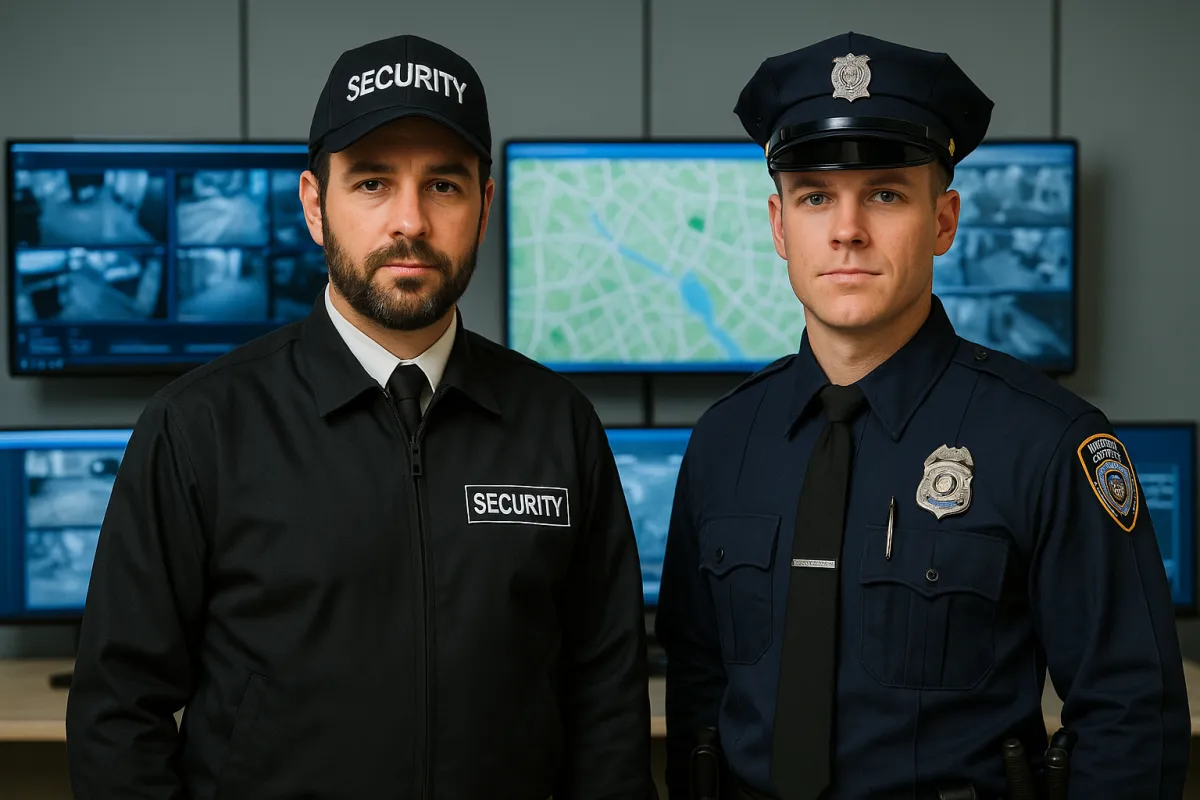Blog & News

How Our Security Teams Collaborate with Local Law Enforcement
How Our Security Teams Collaborate with Local Law Enforcement
In an increasingly complex threat environment, private security cannot operate in isolation. Effective protection of people and property requires seamless teamwork between security officers and public safety agencies. At Steel Bison Security, we cultivate strategic partnerships with local police, sheriffs, and emergency responders—ensuring faster response times, shared intelligence, and coordinated action plans.
1. Why Collaboration Matters
1.1 Amplified Coverage and Deterrence
When private guards and sworn officers patrol in a unified manner, criminal elements are far less likely to test security perimeters. Shared patrols and overlapping jurisdictions send a powerful deterrent message, bolstering both property and community safety.
1.2 Rapid, Coordinated Response
Proprietary systems and dispatch centers can notify law enforcement at the first sign of trouble, reducing response times by up to 30% compared to uncoordinated calls citeturn0news1. This speed is critical during time-sensitive events such as active threats or medical emergencies.
1.3 Shared Intelligence and Threat Awareness
By exchanging incident reports, trends, and local crime statistics—such as those from the FBI’s Uniform Crime Reports—both sectors maintain a holistic threat picture. This real-time intelligence sharing prevents blind spots and helps anticipate emerging risks.
2. Establishing Formal Partnerships
2.1 Memoranda of Understanding (MOUs)
A formal MOU clarifies roles, responsibilities, and resource commitments. It defines points of contact, data-sharing protocols, and dispatch procedures—laying the groundwork for a legally sound and mutually beneficial relationship.
2.2 Liaison Officers
Appointing dedicated liaison officers—one from the security firm and one from the law enforcement agency—ensures direct communication channels. Regular monthly briefings keep both teams aligned on upcoming events, staffing changes, and local crime trends.
2.3 Joint Advisory Committees
Bringing together executives and command staff from both organizations fosters strategic planning. These committees review incident statistics, assess collaborative performance, and set priorities for joint training and technology investments.
3. Joint Training and Scenario Exercises
3.1 Tabletop Simulations
Police and security supervisors convene around maps and floorplans to walk through hypothetical incidents—hostage situations, bomb threats, or natural disasters. These exercises, modeled after the FEMA Homeland Security Exercise and Evaluation Program, refine protocols and communication flows.
3.2 Live-Action Drills
Co-hosted drills might include active-shooter simulations, building evacuations, or traffic control during large events. By intermixing silver command (law enforcement) and security officers in the field, participants build trust and learn to anticipate each other’s tactics.
3.3 Cross-Certification Programs
Inviting officers to attend each other’s certification courses—such as crisis intervention training for security guards and private-sector security standards for police—increases mutual understanding of legal powers, limitations, and best practices.
4. Communication Protocols & Information Sharing
4.1 Secure Radio Integration
Linking private guard radios to police dispatch consoles on dedicated talk groups enables immediate escalation. Encryption and strict access controls ensure sensitive tactical information remains protected.
4.2 Shared Incident Management Systems
Platforms like CommandCentral Aware or Spillman Flex allow joint logging of alarms, digital evidence, and field notes. These centralized dashboards ensure that both sectors see the same data in real time.
4.3 Automated Alerts and Notifications
When a guard logs a critical event—unauthorized access, medical distress—automated notifications (SMS, email, mobile-app push) alert designated law enforcement contacts within seconds, ensuring no human handoff delays.
5. Incident Response Coordination
5.1 Unified Response Plans
Combining private-sector SOPs with public-sector incident action plans (IAPs) creates a single playbook for emergencies. Whether it’s a fire, active threat, or environmental hazard, roles such as “Perimeter Security,” “Crowd Control,” and “First Aid” are pre-assigned to teams from both organizations.
5.2 On-Scene Command Centers
During high-risk events, joint command posts staffed by security and police commanders coordinate resources, manage media relations, and author official after-action reports, streamlining decision-making.
5.3 Post-Incident Debriefs
After any significant incident, both teams conduct structured debriefs to capture lessons learned—what communication channels worked, where delays occurred, and how protocols can be improved.
6. Legal & Regulatory Framework
6.1 Jurisdictional Boundaries
While security guards lack sworn authority, a well-drafted MOU clarifies arrest powers (e.g., citizen’s arrest provisions) and defines when and how to transfer custody to law enforcement.
6.2 Liability Considerations
Shared liability clauses in contracts and MOUs protect both parties. Indemnification provisions and insurance requirements—general liability, E&O, workers’ compensation—ensure financial exposure is managed.
6.3 Data Privacy & Freedom of Information
Agreements must address the handling of personal data, surveillance footage, and incident logs in compliance with laws such as the California Public Records Act or equivalent state statutes, protecting confidentiality while enabling transparency.
7. Technology Integration for Unified Operations
7.1 Shared CCTV and Analytics
By granting police access to private CCTV feeds—subject to strict protocols—live video can inform tactical decisions. AI-driven analytics (threat detection, perimeter breaches) trigger joint alerts.
7.2 Mobile Data Terminals (MDTs)
Equipping security supervisors with MDTs connected to law enforcement databases (NCIC, stolen-vehicle databases) allows on-the-spot checks for warrants or stolen property during patrols.
7.3 GPS-Verified Mobile Patrols
Integrating guard patrol apps with police AVL (automatic vehicle location) systems provides a unified operational picture—showing which units are closest to an incident, regardless of agency.
8. Community Policing & Public Safety Initiatives
8.1 Neighborhood Watch Partnerships
Security officers participate in local neighborhood watch meetings, sharing insights on suspicious activity and reinforcing community bonds—augmenting police outreach efforts championed by the National Sheriffs’ Association.
8.2 School and Campus Safety Programs
Joint “Safety Walks” at schools, where security and school resource officers collaborate with students, parents, and staff, reinforce trust and identify environmental vulnerabilities such as broken lighting or faulty locks.
8.3 Public Awareness Campaigns
Co-branded campaigns—“Lock It or Lose It,” “Report Suspicious Activity”—leveraging both private and public logos, amplify reach and encourage community members to view security as a shared responsibility.
9. Case Study: A Successful Joint Operation
Background: A suburban shopping center faced a spike in catalytic converter thefts.
Action:
Shared Intel: Guards documented theft patterns and provided geotagged photos to the local sheriff’s office.
Coordinated Patrols: Security and deputies alternated nighttime patrol routes, increasing unpredictability for thieves.
Technology Deployment: CCTV analytics flagged hot-spot areas; police MDTs pushed alerts to on-duty deputies.
Community Outreach: A joint press release educated the public on deterrent tactics (etched VINs, parking strategies).
Outcome: Over a three-month period, thefts dropped by 92%, and several arrests were made during coordinated stakeouts.
10. Measuring Effectiveness & Continuous Improvement
10.1 Key Performance Indicators (KPIs)
Response Time Reduction: Time from guard alert to law enforcement arrival.
Incident Resolution Rate: Percentage of incidents resolved without escalation.
Training Participation: Joint exercise attendance and drill success rates.
Crime Rate Trends: Comparative analysis of targeted crime categories before and after collaboration.
10.2 Regular Review Cycles
Quarterly joint performance reviews ensure goals are met, challenges are addressed, and strategies are updated to reflect evolving threat landscapes.
11. How Steel Bison Security Facilitates Collaboration
At Steel Bison Security, we make law enforcement partnerships seamless:
MOU Development: Crafting clear agreements on roles, data sharing, and liability protections.
Liaison Program: Assigning dedicated Security-Agency Liaisons for 24/7 coordination.
Joint Training Schedules: Organizing quarterly scenario exercises with local police departments.
Technology Onboarding: Integrating our patrol apps, CCTV analytics, and MDT interfaces with agency systems.
Community Engagement: Co-hosting public safety forums and neighborhood watch meetings.
Learn more on our services page or connect through our contact page.
12. Conclusion
Collaboration between private security teams and local law enforcement is not optional—it’s a strategic imperative. Through formal partnerships, joint training, synchronized communication, and shared technology, both sectors amplify their strengths and close security gaps. Steel Bison Security’s commitment to forging these alliances ensures that our clients benefit from the combined expertise and authority of public safety agencies, delivering a safer environment for businesses, patrons, and communities alike.
Elevate your security posture—partner with Steel Bison Security and local law enforcement for comprehensive protection. Contact us today.

EMAIL ADDRESS
OFFICE NUMBER
OFFICE ADRESS
(WA) 11900 NE First St STE 3066, Bellevue, Wa 98005
(WY) 30 N. Gould St STE R, Sheridan, Wy 82801
Copyright 2024 Steel Bison Security Services
